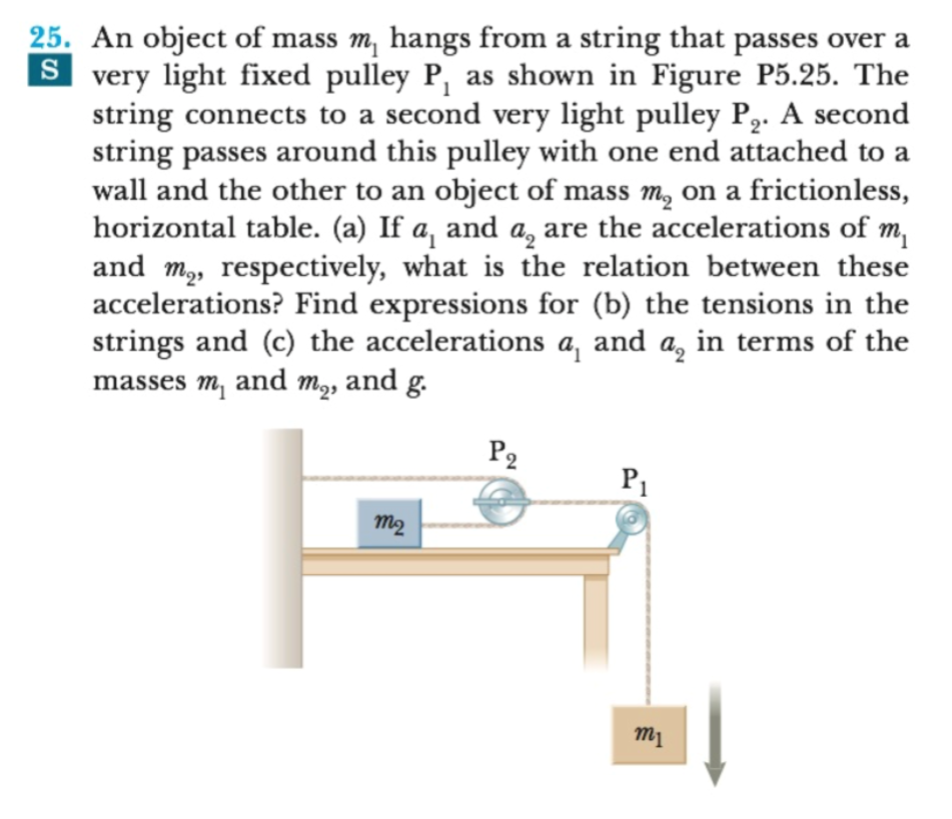25. An object of mass m, hangs from a string that passes over a very light fixed pulley P, as shown in Figure P5.25. The string connects to a second very light pulley P2. A second string passes around this pulley with one end attached to a wall and the other to an object of mass m, on a frictionless, horizontal table. (a) If a, and a, are the accelerations of m and m, respectively, what is the relation between these accelerations? Find expressions for (b) the tensions in the strings and (c) the accelerations a, and ag in terms of the masses m, and m2, and g. 1 т2 тi
25. An object of mass m, hangs from a string that passes over a very light fixed pulley P, as shown in Figure P5.25. The string connects to a second very light pulley P2. A second string passes around this pulley with one end attached to a wall and the other to an object of mass m, on a frictionless, horizontal table. (a) If a, and a, are the accelerations of m and m, respectively, what is the relation between these accelerations? Find expressions for (b) the tensions in the strings and (c) the accelerations a, and ag in terms of the masses m, and m2, and g. 1 т2 тi
Physics for Scientists and Engineers with Modern Physics
10th Edition
ISBN:9781337553292
Author:Raymond A. Serway, John W. Jewett
Publisher:Raymond A. Serway, John W. Jewett
Chapter5: The Laws Of Motion
Section: Chapter Questions
Problem 25P: An object of mass m1 hangs from a string that passes over a very light fixed pulley P1 as shown in...
Related questions
Question

Transcribed Image Text:25. An object of mass m, hangs from a string that passes over a
very light fixed pulley P, as shown in Figure P5.25. The
string connects to a second very light pulley P2. A second
string passes around this pulley with one end attached to a
wall and the other to an object of mass m, on a frictionless,
horizontal table. (a) If a, and a, are the accelerations of m
and m, respectively, what is the relation between these
accelerations? Find expressions for (b) the tensions in the
strings and (c) the accelerations a, and ag in terms of the
masses m, and m2, and g.
1
т2
тi
Expert Solution
This question has been solved!
Explore an expertly crafted, step-by-step solution for a thorough understanding of key concepts.
This is a popular solution!
Trending now
This is a popular solution!
Step by step
Solved in 7 steps with 7 images

Recommended textbooks for you

Physics for Scientists and Engineers with Modern …
Physics
ISBN:
9781337553292
Author:
Raymond A. Serway, John W. Jewett
Publisher:
Cengage Learning

Physics for Scientists and Engineers
Physics
ISBN:
9781337553278
Author:
Raymond A. Serway, John W. Jewett
Publisher:
Cengage Learning

Physics for Scientists and Engineers, Technology …
Physics
ISBN:
9781305116399
Author:
Raymond A. Serway, John W. Jewett
Publisher:
Cengage Learning

Physics for Scientists and Engineers with Modern …
Physics
ISBN:
9781337553292
Author:
Raymond A. Serway, John W. Jewett
Publisher:
Cengage Learning

Physics for Scientists and Engineers
Physics
ISBN:
9781337553278
Author:
Raymond A. Serway, John W. Jewett
Publisher:
Cengage Learning

Physics for Scientists and Engineers, Technology …
Physics
ISBN:
9781305116399
Author:
Raymond A. Serway, John W. Jewett
Publisher:
Cengage Learning

Physics for Scientists and Engineers: Foundations…
Physics
ISBN:
9781133939146
Author:
Katz, Debora M.
Publisher:
Cengage Learning

Principles of Physics: A Calculus-Based Text
Physics
ISBN:
9781133104261
Author:
Raymond A. Serway, John W. Jewett
Publisher:
Cengage Learning

College Physics
Physics
ISBN:
9781285737027
Author:
Raymond A. Serway, Chris Vuille
Publisher:
Cengage Learning